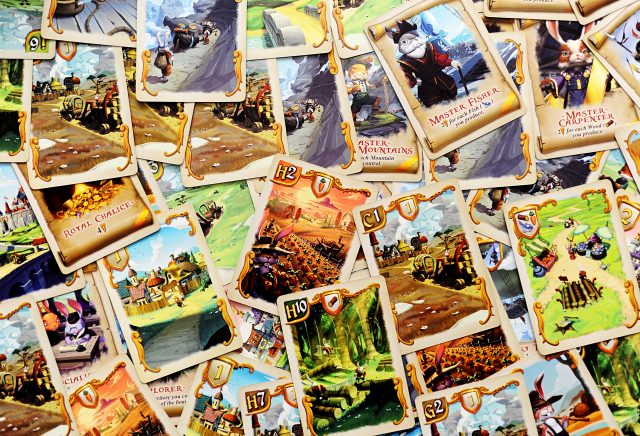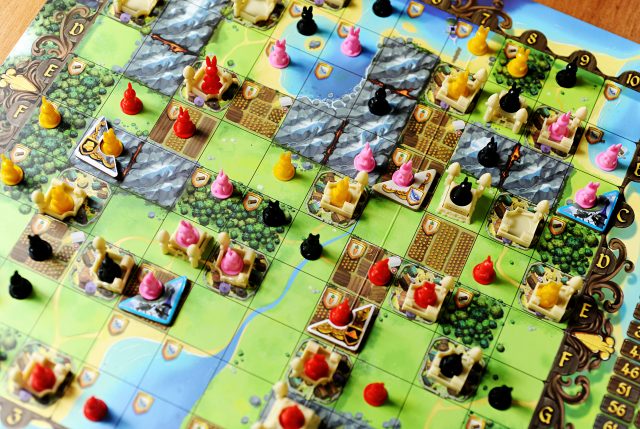The lands that your home warren have inhabited for years have become too small and crowded. You are, after all, rabbits. The King has decreed that you must venture forth a find new territories where the empire might flourish for years to come. However, there will be competition, as other rabbit Lords seek to win the King’s approval as well. You’ll have to muscle out your opponents if you hope to create a new home in a powerful Bunny Kingdom.
 Bunny Kingdom is a new game by Richard Garfield and published by Iello. It combines card drafting and a sort of board control over four rounds, as up to four bunny Lords seek to claim territory in the new world.
Bunny Kingdom is a new game by Richard Garfield and published by Iello. It combines card drafting and a sort of board control over four rounds, as up to four bunny Lords seek to claim territory in the new world.
The board consists of a 10 x 10 grid, with letters across the side and numbers across the top creating coordinates. Each of the 100 spaces is a territory. Territories can be Forests, Fields, or Seas, which produce resources (Wood, Carrots, and Fish respectively), Mountains or Plains, which produce no resources, or Cities. Our intrepid bunny explorers are not the first to discover the new world (as is often the case), and several small cities cover the board at the beginning of the game.
Each round, a hand of 10 or 12 cards (depending on the number of players) are dealt out to each player. Turns are taken simultaneously, as players select two cards from their hand to keep and pass the remaining cards from their hand on to the left or right (depending on the round). The goal is to select the best cards to allow yourself to gain valuable land and establish different fiefs that will score you points between the rounds.
 The deck is made up of Exploration cards with different properties. Territory cards have the coordinates of one of the territories on the board, with a helpful picture to be able to identify them quickly. When players draft Territory cards they’ll reveal them and place one of their bunny meeples in the appropriate space on the board, claiming it for their rabbit lord.
The deck is made up of Exploration cards with different properties. Territory cards have the coordinates of one of the territories on the board, with a helpful picture to be able to identify them quickly. When players draft Territory cards they’ll reveal them and place one of their bunny meeples in the appropriate space on the board, claiming it for their rabbit lord.
Building cards allow players to add different constructs to the board. Farms can add to the resources that are produced on a territory. City cards have a strength of 1, 2, or 3 and allow players to add cities of that strength to the board. The strength of the city is represented by the number of towers. Camp cards allow players to build temporary camps on territories. Sky Bridges come in pairs and can be used to connect two fiefs through an invisible aerial link (think the Study and the Conservatory in CLUE). Building cards are flipped up, but won’t get built until the end of each round.
Finally, there are Parchment cards. These consist of either Missions or Treasures. Missions give players goals, like controlling the most territories at the end of the game, having rabbits in the corners of the board, or producing a lot of a certain resource. Treasures are simply end game points. Parchments aren’t revealed with the other Exploration cards. They’ll stay face down until the end of the game. Players can see how many Parchments someone has, but not the goals they’re working towards.
 In the Exploration phase, all the cards dealt that round are drafted and passed. After the last reveal of the round, the Construction phase begins. In this phase players can build the camps, farms, buildings and sky bridges that they acquired during the round. This timing is helpful in allowing players to maximize the value of the buildings they’ve gotten their hands on.
In the Exploration phase, all the cards dealt that round are drafted and passed. After the last reveal of the round, the Construction phase begins. In this phase players can build the camps, farms, buildings and sky bridges that they acquired during the round. This timing is helpful in allowing players to maximize the value of the buildings they’ve gotten their hands on.
Rounds are completed with the Harvest phase. It’s basically a scoring phase, where players will earn points for the territories they’ve claimed so far. The scoring is easy enough in the first round, but quickly becomes more complicated, with the final round being an all out beast. Each different fief is scored for the amount of different resources multiplied by the number of towers in it. So, if a grouping of a player’s bunny explorers produced a wood and a fish and had two different towers in their cities, they would earn four points (two unique resources times two towers).
After the Harvest, you rinse and repeat over four rounds. After the fourth round, players will also score out their Parchment cards, earning points for their Treasures and completing their Missions.
Bunny Kingdom has a lot of interesting elements going on in it. There’s a decision to make whether to invest into building up the value of different fiefs with chasing after Missions and the end game points they’ll yield. Camps are an interesting prospect. They give players temporary control over an area, but they’ll be kicked out of the space as soon as someone plays the actual Territory card for that space. Still, it can be worth it to cash in on a big multiplier.
 I have had a lot of fun playing Bunny Kingdom with a wide range of gamers. It’s light theme and super cute bits make it an attractive package. However, I find myself taking on the task of doing the scoring each round, which I mentioned, can be a bit overwhelming. The complexity is not in the rules, but the visuals. There is a lot going on on that board, and when you add in Sky Bridges connecting different fiefs it’s even more to take in.
I have had a lot of fun playing Bunny Kingdom with a wide range of gamers. It’s light theme and super cute bits make it an attractive package. However, I find myself taking on the task of doing the scoring each round, which I mentioned, can be a bit overwhelming. The complexity is not in the rules, but the visuals. There is a lot going on on that board, and when you add in Sky Bridges connecting different fiefs it’s even more to take in.
Now, I’m a sucker for drafting games. So, it’s a pretty safe bet I’m going to give Bunny Kingdom a positive review. It’s fun and fast, the components and art are pretty nice, and if you can get past the scoring, you’ll really enjoy this game. It does something I haven’t seen a lot, which is successfully combining drafting with board presence. If you are worried about the scoring, let me say that after a couple of games, you’ll get pretty good at it and it shouldn’t be a problem for you. If you want to try a different drafting game by Richard Garfield, I can’t recommend Treasure Hunter enough. That is one of my favourites to employ that mechanic.
–
A media copy of Bunny Kingdom was generously provided by Iello for this review.
Comments
No comments yet! Be the first!